
 |
|
|
|
Japanese director Nagisa Oshima's films are the big "No" to the humanist position represented by Japan's premier filmmaker Akira Kurosawa. While Kurosawa was mixing Yojimbo with Dr. Kildare for his heart-tug medical movie Red Beard, Oshima was breaking new ground in radical political cinema. Unconcerned with genres or trends, he continued to make highly regarded pictures after much of the Japanese commercial cinema had collapsed. His most famous title is the notorious In the Realm of the Senses, which links radical politics to sexual excess. The film had to be finished in France, as no Japanese laboratory would process Oshima's hardcore sex scenes. Not soon after breaking into the business, Nagisa Oshima left the Shochiku studio after they withdrew from exhibition his Night and Fog in Japan, a film critical of Japanese politics both Left and Right. Oshima later opened his own studio called "Creation Company", and embarked on a group of movies difficult to categorize into standard genres. The characters are obsessed with sex, politics and crime, but with weird thematic twists. Oshima's concern for his country's discrimination against Koreans is a frequent theme. None of the five titles in Eclipse's Oshima's Outlaw Sixties collection are similar in plot or construction. All have a quirky fragmented style and make odd use of the camera (sequences built from nervous panning shots, for instance). Oshima is unsentimental to a fault but never cruel for cruelty's sake. Very little in his films has dated, mainly because politics is used as a contextual background; nobody proclaims a specific political position. 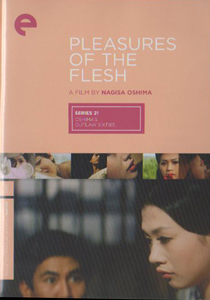
Pleasures of the Flesh (Etsuraku Color, 1965) is the closest these pictures come to film noir. Based on a novel by Futaro Yamada, Oshima's screenplay reminds us of stories by Cornell Woolrich. The lowly tutor Atsushi (Katsuo Nakamura) is sexually obsessed with his beautiful pupil, and commits a murder to defend her honor. An embezzler blackmails him with this knowledge, forcing him to watch over a suitcase packed with stolen money: after serving his prison term, the embezzler will return to claim it. But the tutor can't help himself and determines to spend all of the money on sex and debauchery. Of course, the tutor's infatuation with his pupil is misplaced. His plans are disrupted when the embezzler gets out of prison early for good behavior. Uh oh. 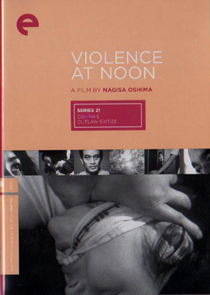
Violence at Noon (Hakuchu no torima, a.k.a. Violence at High Noon B&W, 1966) is a twisted serial killer tale made long before that subgenre became standard thriller fare. Based on a real criminal called the 'Daylight Demon', the maniac Eisuke (Kei Sato) murders women at high noon. The maid of one of his victims turns out to be Shino (Sae Kawaguchi), an ex-lover from his rural past. Eisuke was once involved in an agrarian cooperative and married a teacher, Matsuko (Akiko Koyama). The two women prove unwilling to aid the authorities in catching Eisuke, and instead play out a strange game of sex and death mirroring awful events that brought the cooperative to an end - events that included a double suicide pact by the cooperative's promising political leader. Violence at Noon is visually quite radical as well, with unpredictable cutting and panning patterns: long held close-ups alternating with fast intercuts. 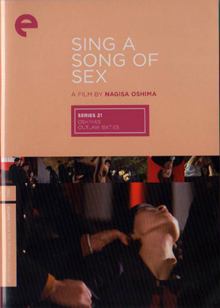
Sing a Song of Sex (Nihon shunka-ko Color, 1967) is one of the weirdest political films ever. Its point seems to be that student activism is no longer possible because the passions of youth are warped by sexual obsession and alienation. A group of four male college applicants harass their female peers with crude suggestions, pursue a teacher's girlfriend to find out if she's a hooker and obsess over qualifying exam student #469, an arresting beauty. The teacher invites the boys and a group of girls for a night of drinking. He lectures them about the political significance of folk songs -- songs of work & marriage, and rowdy songs of sex that represent a form of social liberation for the poor. But the teacher dies when he accidentally disconnects a gas heater hose -- and the most alienated of the boys does nothing about it. The police investigation gets nowhere, but the boys taunt the girls by claiming they murdered the teacher. The boy responsible approaches the dead teacher's girlfriend, while the other three pursue #469 at a folk music festival. One of the girls at the party, moved by the teacher's last speech, sings a prostitute's song; she's the target of discrimination because she's Korean. The story toys with the boys' fantasies of rape, which are followed by 're-creations' of the teacher's death, a 're-creation' of the fantasized rape and also a real rape. The political energy of youth is channeled into antisocial violence, particularly against women. Sing a Song of Sex is difficult to pin down. The boys pass by posters of Japanese sex films (and what looks like a poster for Torn Curtain) and then a parade for Japan's newly reborn archconservative movement. The political energy of the left is expended at a big folk rally, where songs of Pete Seeger and The Weavers are sung in English (a weird scene). The most alienated of the boys can't explain his actions. It's as if none of them have experienced life and don't know what to make of real human contact or responsibility. The boys disrupt the teacher's wake by singing one of the bawdy songs he had taught them. The teacher's wider political wisdom will be forgotten. The movie also uses a subversive graphic motif of the Japanese flag to make strange comments. A flag is 'created' behind the main titles when blood soaks into a white cloth (and then catches fire). A lecture hall table becomes a sacrificial altar during a fantasy (?) rape, when it is suddenly draped in the national flag. 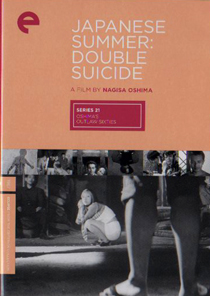
Japanese Summer: Double Suicide (Muri-shinju; Nihon no natsu B&W, 1967) takes place in a Theater of the Absurd landscape seemingly motivated by the growing wave of American violence -- riots and mass murders. The cartoonish characters are stripped down to one theme apiece. The sex crazed Nijiko (Keiko Sakurai) meets a nameless suicidal deserter (Kei Sato) who won't make love to her. Gangsters imprison them in a disused cellar with other social outcasts: a man who hates foreigners, a gun-crazy high schooler, etc.. The gangsters intend some kind of violent action the next morning, as several clans have come together to receive weapons. News comes over a Television about a foreigner randomly shooting people with a high-powered rifle. Whatever the uprising or assault was meant to be, it gets canceled. The prisoners break out with guns and swords, at first rushing to kill the "Man from Dallas". But they change their minds and elect to help him in his battle with the police. The crazy Japanese Summer: Double Suicide seems to play out in the fevered imagination of one obsessed by violent cultural trends. Oshima's characters all want to arm themselves. Nijiko offers herself enthusiastically to every man she meets but is repeatedly frustrated; when not dancing to unheard music she's trying to seduce somebody: "I lost all my underwear!" Another prisoner is a maniac that loves to kill with knives, and yet another is an old man brandishing a Mauser pistol. Oshima keeps the visuals strange. The walls of the concrete cellar evolve throughout the picture, until we realize that they have become a chalk mural. Nijiko and the deserter lie down on chalk drawings of people drawn in the middle of a highway, indicating that they'll eventually become the suicide couple of the title. Everybody seems keen to die in this madhouse, which makes the outcasts' excited efforts to communicate with the foreigner -- a clean-cut American boy with a deer rifle -- all the more poignant. Shedding a tear for his new friends, the Yankee mass killer is presented as some kind of twisted messiah. 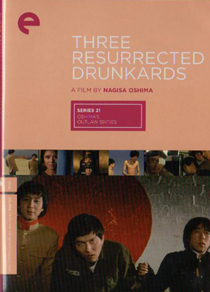
The five-title collection ends with the less bloodthirsty but equally bizarre comedy Three Resurrected Drunkards (Kaette kita yopparai Color, 1968). Three young men play games on the beach that immediately remind us of the famous, disturbing news coverage of a Vietnamese man being executed by a South Vietnamese security official. As in a goofy teen comedy, a trio of illegal immigrants from Korea steals the boys' clothing. A chase ensues that sees the boys mistakenly pursued by the police and aided by a girl being pimped out by her one-eyed, hook-handed father -- or is it her husband? None of the boys is a drunkard, but the 'resurrected' part of the title becomes clear at about the forty-minute mark, when the movie suddenly begins to repeat itself. I had to confirm that I hadn't accidentally restarted the disc, and then noticed that this second pass at the story soon veered in a different direction, with the boys taking an altered attitude toward their mistaken status as Koreans. The immigrants have fled Korea to avoid forced conscription to fight the American war in Vietnam, and the film resolves in a flat-out condemnation of the War and discrimination against Koreans. The brightly colored film is like a juvenile TV sitcom, mutated into a political statement. Eclipse's DVD of Oshima's Outlaw Sixties contains five very clean and bright transfers of these handsomely filmed shows; one wonders if they were popular in Japan or considered fringe art material. As with all Eclipse releases, the only extras are the highly informative -- and in this case indispensible -- liner notes by Michael Koresky. I'd hate to have to explain the significance of these unusual pictures in the limited space he's been given. On the visual plane Nagisa Oshima's films are way ahead of the game - little being made in America or Europe at this time is as progressive or challenging. Koresky tells us that the famous Yukio Mishima saw one of these challenging intellectual films and told Oshima outright that he simply didn't understand it. Now that's an endorsement!
On a scale of Excellent, Good, Fair, and Poor,
Oshima's Outlaw Sixties rates:
Reviews on the Savant main site have additional credits information and are often updated and annotated with reader input and graphics. Also, don't forget the 2010 Savant Wish List. T'was Ever Thus.
Review Staff | About DVD Talk | Newsletter Subscribe | Join DVD Talk Forum |
| ||||||||||||||||||